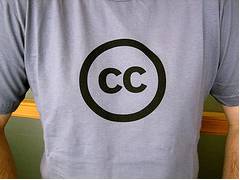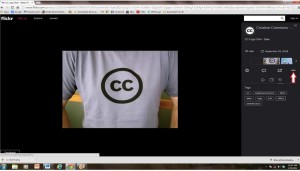
Blog posts, websites, book covers, bookmarks, trailers. For writers, we sure do use a lot of photographs.
If you’re like me, your photography skills leave a lot to be desired. Luckily, there are some inexpensive (even free) options available, but that doesn’t necessarily mean we can download and use willy-nilly.
More often than not, there are some requirements we must meet in order to use even free photographs. Otherwise, we might find ourselves on the wrong side of a copyright infringement suit.
Creative Commons is my favorite place to search, because they make it easy to find free photos, artwork, music, and audio. They have very specific requirements for use, however. Let’s walk through the process.
You’ll first see this screen:
Just enter your search query (for the photo at the top of this post I entered, “Creative Commons Logo”), and choose the site you want to search. I chose Flickr, which brought up a screen full of Creative Commons logos. I clicked on the t-shirt above and was taken here:
 This screen shows both the name of the photograph and the name of the photographer. I made a note of both, because I’ll need them for later.
This screen shows both the name of the photograph and the name of the photographer. I made a note of both, because I’ll need them for later.
But first, Creative Commons says it’s showing me free photos, but I need to make sure. After all, it’s not Creative Commons who could be sued; it’s me. On the far right of the screen there are three little dots (see arrow above). I clicked on those for a dropdown menu and selected “Download/All Sizes,” which took me here:
 In small print at the top (see arrow above) is the word “Licenses.” I can see that the photographer, CreativeCommoners, has some rights reserved. I click on the link to see what, if anything, I’m allowed to do with this photo. That takes me here:
In small print at the top (see arrow above) is the word “Licenses.” I can see that the photographer, CreativeCommoners, has some rights reserved. I click on the link to see what, if anything, I’m allowed to do with this photo. That takes me here:
 The photographer has made the photo available under a Creative Commons 2.0 Attribution. That means I can use and even adapt the photo for any purpose, even commercially, but only if I give proper attribution. I must acknowledge any modifications, give appropriate credit, and provide a link to the license. For example (the brackets are just to describe what I’ve done and wouldn’t be included in the actual citation):
The photographer has made the photo available under a Creative Commons 2.0 Attribution. That means I can use and even adapt the photo for any purpose, even commercially, but only if I give proper attribution. I must acknowledge any modifications, give appropriate credit, and provide a link to the license. For example (the brackets are just to describe what I’ve done and wouldn’t be included in the actual citation):
CC Logo Shirt [photo name], by CreativeCommoners [photographer name], available here [photo link]: http://www.flickr.com/photos/creativecommons/2900307100/ under a Creative Commons Attribution 2.0. More licensing information here [link to license]: http://creativecommons.org/licenses/by/2.0/
I didn’t make any changes to the photo, but if I had I might have tagged on something like, “Photo cropped from original.”
If I used a Creative Commons licensed photo for a book cover, I’d put the attribution on the copyright page. If I used it in a blog post, I’d include the information with the post. The attribution must be included wherever you used the photo, music, audio, etc.
Not every item found through Creative Commons is under an attribution license, so it’s important to check. Some have all rights reserved (meaning they can’t be used without explicit permission obtained from the artist), and some are in the public domain, meaning no one owns the copyright and anyone can download and use them for any purpose. It isn’t necessary to “cite” public domain works, but I usually do, just so there’s no question regarding copyright. I use the same format used for Creative Commons attributions but with a link to Public Domain Mark 1.0: http://creativecommons.org/publicdomain/mark/1.0/
Although it isn’t required, I do the same for Microsoft Word ClipArt, with a link to that license: http://windows.microsoft.com/en-us/windows-live/microsoft-services-agreement
It only takes a moment, and I’m a fan of proactive versus reactive. If questioned (as happened recently with a book trailer), it’s nice to have information in hand in order to quickly resolve any issues that might arise.


nice idea about giving credit re any usage, just in case; and even though i only use my own images, gonna bookmark this, very handy info, and who knows when i may need to augment 😉 thanks melinda!
You’re very welcome, Felipe. Thanks for stopping by!
Great post, better to be safe then sorry later on.
Thanks, Frank! It’s such an easy thing to do to avoid getting in trouble – I hate getting in trouble. 😉
Thank you for another option. I am always boggled by this and end up being asked for payment. It’s been a frustrating process. This helps.
I’m glad it helps, Yvonne! There’s a ton of beautiful work out there (photos, audio, etc.) that’s free with the proper attribution.
Thanks for the info, Melinda. I’m even leery of Microsoft clipart when it comes to their photos. I just searched for “angry” and got a number of photos from Fotolia, which you typically have to pay for. Any idea whether it’s okay to use these? Maybe with a copyright notice along the lines of, “Fotolia via office.microsoft.com”?
I should clarify – ClipArt included through a Microsoft Office package you’ve bought is free, but their online office media gallery isn’t always free. It quite often pulls up images from other places, such as Fotolia and iStockPhoto. In those cases, I go directly to that site to see what the licensing agreements are. Items from those sites typically aren’t free (and I always find it a little off-putting that they pop up in searches for “free” media).
Melinda, great post and very handy. I’m constantly searching for images and it seems so easy to just grab them as they come up (but NOT a good idea!). I will check out the Commons first from now on. Thanks!
Thanks, Melissa – glad it was helpful!
Thank you Melinda! Great information.
Thanks, CM!
Thanks, Melinda. Great resources!
Thanks, Lois!
Thanks Melissa, for a heads up in this sometimes very ambiguous area.
You’re very welcome. 🙂
That’s great info. Thanks.
Hope it comes in handy. 🙂
Excellent article, Melinda. It’s the best policy to be proactive, attribute the work as appropriate, and keep good records. YouTube questioned me once about a musical piece in one of my book trailers, and I was able to produce the appropriate usage license right away.
Thanks, Lita. I had the same exact experience with YouTube just a couple of weeks ago. You’re right – it was wonderful to be able to send them the requested information immediately. It was even more wonderful to see the claim “released.” 🙂
Great post, Melinda. This is a minefield area that will just keep getting bigger as more and more data is uploaded to the net. Thanks for the info.
It definitely is, AC. Thanks for stopping by!